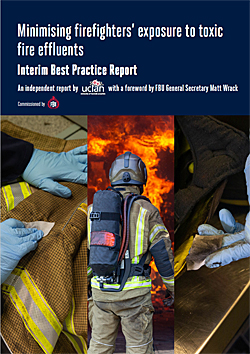 |
|
|
|
It is estimated that firefighters are 323% more likely to be diagnosed with cancer compared to the general population, and estimates that at any one time approximately 4% of firefighters have been diagnosed with some form of cancer. The FBU decided to commission a report on the exposures levels and types and ways of m9tgating exposure to carcinogens, and employed the University of Central Lancashire to investigate the risks and hazards to firefighters when attending incidents. The Fire Brigades Union, describes the report on their website as: 'An independent report from the University of Central Lancashire (UCLan), commissioned by the FBU, As a best practice report it aims to help protect firefighters’ health by highlighting some of the risks and common sources and suggesting preventative measures for minimising exposure to contaminants and best practice for the decontamination of FRS personnel and firefighting equipment after exposure to toxic fire effluent.
One of the most significant and explanatory statements in the report details the health risks associated with the effluents produced in a fire and its health risks due to exposure: 'Fires produce a cocktail of toxic, irritant and carcinogenic chemicals – the composition of which varies depending on the specific materials burning and the fire conditions. They can be released in the form of particulates which will include aerosols, dusts, fibres, smoke and fumes or gases and vapours. (Duffus & Worth, 2006) Some of these fire effluents (e.g. carbon monoxide, hydrogen cyanide and acid gases) have immediate adverse effects on health after only a single or short exposure (e.g. asphyxiation). This is known as acute toxicity. However, most other fire effluents (e.g. volatile organic compounds, or polycyclic aromatic hydrocarbons) have much longer-term adverse effects on health, causing conditions which are more complex and can develop more slowly e.g. cancer, cardiovascular (related to the circulatory system which comprises the heart and blood vessels) and neurological (nervous system) diseases. This is known as chronic toxicity. Repeated exposure to even very small amounts of chronic toxicants over time increases the likelihood of developing long-term health conditions. Harm to health depends on the toxicity of the contaminant, but also on the exposure pathways via which an individual is exposed to the contaminant, and the dose (amount) of the contaminant an individual is exposed to (Duffus & Worth, 2006).' The report is available in full by clicking on the image above, and is also available from the Unionsafety E-Library here by using the search category of 'Trade Union Reports' It is written in such a way that non-firefighting safety reps will be able to glean important information about the hazards in modern furniture and materials that make up a modern home and office, and the inherent dangers from inhalation of the fumes given off in the event of a fire taking hold. Source: FBU / TUC
|

 It provides background information, statistics, resources and actions vital for improving firefighters’ health and well-being, keeping them safe and preventing the contamination which otherwise will lead to serious health conditions resulting in either life-changing problems and/or premature death.'
It provides background information, statistics, resources and actions vital for improving firefighters’ health and well-being, keeping them safe and preventing the contamination which otherwise will lead to serious health conditions resulting in either life-changing problems and/or premature death.'